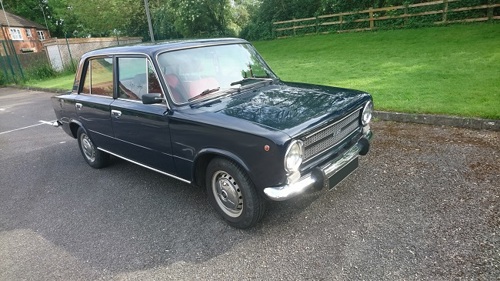RARER THAN RARE – THE FIAT 124
23 December 2024
Such is the 124’s fame as one of the world’s most popular car platforms that the original Fiat version is sometimes in danger of being forgotten. This 1974 last-of-the-line example - is a vivid reminder of the many details of 124 motoring; the strip speedometer, those thin pillars, and those rotary vents in the dashboard. Plus, you could always tell your neighbours it was Car of the Year 1967.

Fiat devised the 124 as the eventual heir to the 1961 1300. Two years later, Oscar Montabone headed the company’s Automobile Technical Office and was put in charge of Project 124. His brief was an affordable rear-wheel-drive saloon offering more room than the 1300 while being cheaper to manufacture and weighing less.
At that time Fiat was evaluating the Primula, a front-wheel-drive transverse engine design made by their Autobianchi subsidiary. They would not make a FWD saloon under their own brand until the 1969 128. The 124 debuted at the Geneva Motor Show in March 1966, and by the 4th May, a signing ceremony took place between Fiat and the Soviet Ministry for the Automobile Industry.
Car magazine of that July believed “It’s no secret that the 124 was created to help the Russians make up their minds about whose car (or factory) they wanted to buy”. In fact, Soviet engineers heavily re-engineered the 124 to create the future Lada and in Italy it had to appeal to former 1300 owners who wanted conventionalism with enjoyable motoring con brio. As the motoring writer Matteo Licata put it: “These were the cars bought by the Italian bourgeoisie; a target market more concerned with their neighbours’ opinion than avant-garde design”.
Furthermore, the 124’s technical specification intrigued many potential buyers. Autocar described the styling as “crisp but undistinguished”, but it was in keeping with Fiat’s tradition of low-key saloons for the Italian middle classes. All-disc brakes were very unusual in this market sector, and the sole legacy of the 1300 appeared to be the four-speed all-synchromesh gearbox, albeit now with a floor rather than steering column gearchange. Aurelio Lampredi devised a new 1,197cc engine, Fiat’s first four-cylinder unit with a five-bearing crankshaft.
The advertisements promised a top speed of “nearly 90 mph” in “an extraordinary family car”, so call Fiat’s UK head office on ELGar 1951 for more details. In early 1967 the price was £774 5s compared with £693 for a Ford Cortina 1300 4-Door De Luxe Mk.2 and £708 for a Vauxhall Viva SL90 HB. Reclining front seats were a worthwhile extra at £7 19s 2d. Autocar thought the 124 possessed “that indefinable driver-car liaison that puts a man at one with the machine”.
An equally impressed Motor Sport wrote, “It has the life, the light controls, the handling precision of a sporting car”. Better still, “Whereas the Fiat makes me want to drive along the Autostrada del Sol to Florence and Naples, the Cortina 1200 I associate with seaside excursions to Southend in a drizzle”.
Meanwhile, Car apparently had Sidney James temporarily occupying the editor’s chair, praising how the 124’s body had “no bits hanging off to ruin your trousers or the bird’s nylons”. They concluded, “I would not say that I lie awake dreaming about owning one – but then I wouldn’t kick it out of bed either!”.
Appalling 1960s motoring writing aside, the 124’s importance to Fiat cannot be overstated. This example is one of the last before the introduction of the replacement 131 Mirafiori, and a 1966 owner would have been amazed by its reversing lamp and cigar lighter. But the essential formula remained – practicality and enjoyment combined.
And this is before we even mention the famous launch advertisement:
